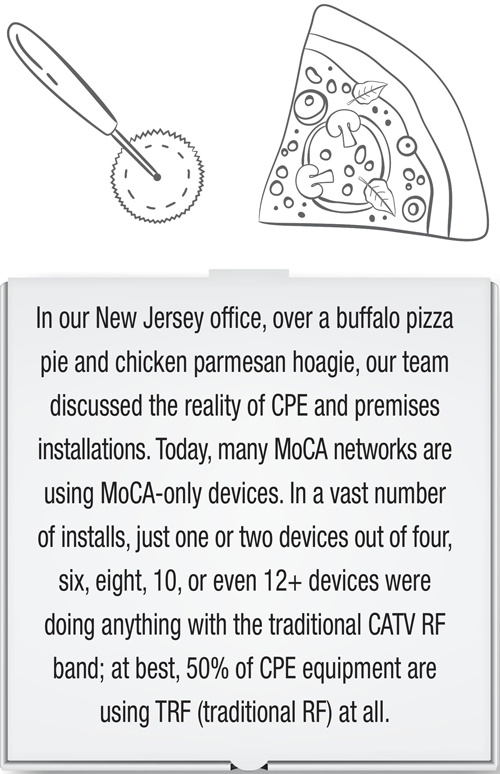MoCA Changing CPE Installations
By Matthew Shapson
MoCA has changed the way customer premises installations are completed. Today’s technicians are dealing with an additional layer of home networking in a frequency range that is being encroached upon by the expanding cable network spectrum.
Technical challenges arise for manufacturers who need to manage independent frequency networks separated by narrow guard bands. Harder still, history has trained RF engineers to strive for the highest port-to-port isolation, although today with the advent of MoCA networks, we need to have the lowest port-to-port isolation in the MoCA frequencies. High isolation from 5 MHz to 1002 MHz, low isolation from 1125 MHz to 1675 MHz. This, “flipping the script” is no easy task and the fine tuning of passive and active premises hardware is tedious and time consuming. We are asking our engineers to design devices that handle two conflicting network ideologies and to do it in a high volume, low cost environment. Challenge accepted!
What are we dealing with? We have a prevalence of house amplifiers where MoCA signals get eaten alive when they hit the active gain stage. We have more devices, more splits, and more signal loss to deal with. We have a price sensitive market and an even greater sensitivity to performance and quality. In the short term, the solution was over engineered amplifiers that ballooned in cost but got the job done pretty well. Long term, the costs to operators is/was unsustainable, there had to be a better solution, a better device, at a better price point.
 In our New Jersey office, over a buffalo pizza pie and chicken parmesan hoagie, our team discussed the reality of CPE and premises installations. Today, many MoCA networks are using MoCA-only devices. In a vast number of installs, just one or two devices out of four, six, eight, 10, or even 12+ devices were doing anything with the traditional CATV RF band; at best, 50% of CPE equipment are using TRF (traditional RF) at all. It was clear then, the premises has become a hybrid of networks and we need hybrid products to support it. Self admittedly, history had us so engrained in the idea of TRF, we, like the rest of the industry, kept doing what we always did and this was a mistake. The same day, using a handful of existing hardware and some old prototype passives from the storage room, we pieced together what would become the industries first, “DOCSIS Passive,” a hybrid product for today’s hybrid networks.
In our New Jersey office, over a buffalo pizza pie and chicken parmesan hoagie, our team discussed the reality of CPE and premises installations. Today, many MoCA networks are using MoCA-only devices. In a vast number of installs, just one or two devices out of four, six, eight, 10, or even 12+ devices were doing anything with the traditional CATV RF band; at best, 50% of CPE equipment are using TRF (traditional RF) at all. It was clear then, the premises has become a hybrid of networks and we need hybrid products to support it. Self admittedly, history had us so engrained in the idea of TRF, we, like the rest of the industry, kept doing what we always did and this was a mistake. The same day, using a handful of existing hardware and some old prototype passives from the storage room, we pieced together what would become the industries first, “DOCSIS Passive,” a hybrid product for today’s hybrid networks.
The DOCSIS Passive actually has a long history with the first, mass-produced model dating back nearly six years to 2012. Today’s version is similar but unique. A hybrid device which utilized TRF where needed, and a quad set of expandable MoCA-only ports to maximize performance on the increasing number of MoCA-only CPE in the home. By focusing on what was being used in the home, we could design a cost-effective, maximum performing device in a small passive package. Today, the DOCSIS Passive is systematically replacing amplifiers, in turn, eliminating power supplies, reducing power supply noise, eliminating ingress, improving system health and the list goes on. The DOCSIS Passive is a unique invention that was created for better performance and ended up becoming something much more.


Matthew Shapson
Director of Marketing, Amphenol Broadband Solutions
mshapson@extreme-broadband.com
Continuing a family tradition, Matthew Shapson has spent his career in the cable industry in a variety of roles including product development, operations, training and marketing. Currently serving as the Director of Marketing at Amphenol Broadband Solutions, Matthew has been a key contributor to the broadband active and passive product lines, holding multiple patents, including the latest, DOCSIS Passive. Amphenol Broadband Solutions is a global leader in communication technology development specializing in the engineering and manufacturing of cable, RF equipment and hardware, fiber optic products and wireless products.
Shutterstock




